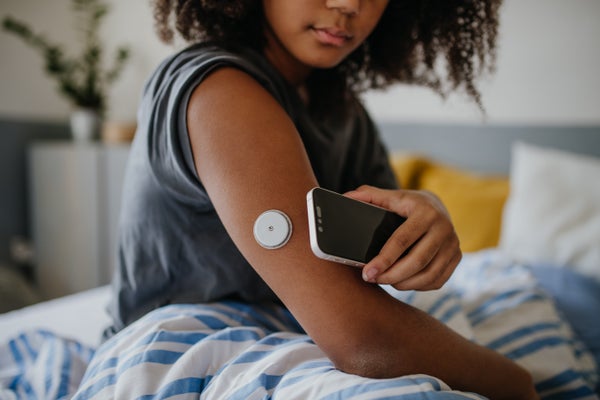In the deepest stage of sleep, slow waves of electrical activity travel through your brain. They help consolidate memories and flush out the buildup of unwanted chemicals, getting you ready for the day. This midnight orchestra is responsible for many of the benefits of a good night’s sleep, such as improved attention, mood and energy levels.
Scientists at the University of California, Berkeley, recently found that for some people, these waves could also serve as early warning signs of diabetes. The results, published in July in Cell Reports Medicine, suggest that getting a restful sleep may help control high blood sugar.
People with type 2 diabetes are unable to metabolize sugar, leading to a damaging excess concentration in the blood. The approximately 515 million people globally with type 2 diabetes can manage blood sugar through diet, exercise and medications such as insulin. But researchers and clinicians have observed that quality of sleep seems to influence blood sugar, too.
On supporting science journalism
If you're enjoying this article, consider supporting our award-winning journalism by subscribing. By purchasing a subscription you are helping to ensure the future of impactful stories about the discoveries and ideas shaping our world today.
“We have known that something magic happens during sleep,” says New York University neuroscientist Gyorgy Buzsaki about the links between sleep and metabolism. Yet the mechanism behind that relationship has been a mystery, he says.
To investigate, the July study’s co-lead author Raphael Vallat, then a postdoctoral researcher at U.C. Berkeley, analyzed blood glucose and sleep measurements from two large independent public datasets. In the first analysis, Vallat and his colleagues examined sleep patterns measured from polysomnography, a standard assessment that doctors recommend for people with sleep problems. The procedure, typically conducted at night, involves placing a bunch of wires on different parts of the head to record activity in specific brain regions. The ends of the wires act like “microphones” that “hear” brain waves, explains Vyoma Shah, a graduate student at U.C. Berkeley and co-lead author of the paper. Squiggles of different shapes and sizes on the polysomnography graphs represent the ebbs and flows of electrical activity in people’s head as they sleep throughout the night. It is only a surface-level view, however.
A previous study that placed wires inside the brains of sleeping rats had more precisely documented blood glucose-related ripples originating from the hippocampus, a brain structure involved in many cognitive functions such as memory, language and learning. But because the hippocampus sits deep within the brain, these currents of activity aren’t captured by polysomnography. Hippocampal ripples, Buzsaki explains, are often triggered when a slow wave, one of the hallmarks of sleep’s deepest stages, is amplified by another type of brain wave known as a spindle—a burst of neuronal activity that is typically tied to the second stage of non-rapid eye movement sleep. Polysomnography can capture both spindles and slow waves, so although they could not directly observe ripples buried in the hippocampus, Shah and Vallat could use the two as a reliable proxy. Whenever they saw coordinated slow waves and spindles, they could be fairly certain that the hippocampus responded with a ripple.
In their next analysis, the researchers examined whether a higher number of coordinated spindles and slow waves had something to do with blood sugar. The team looked at fasting glucose, a baseline measurement that indicates how well someone can flush glucose out of their blood. Vallat and Shah found that people who had more strongly coordinated spindles and slow waves during the previous night’s sleep had lower fasting glucose levels and a higher sensitivity to insulin the next day—these participants seemed to be better at controlling their blood sugar.
Could improving sleep be a way to avoid diabetes? Shah thinks not. Having more coordinated spindles and slow waves “does not really perfectly correlate at all with how well you think you slept,” she says. Vallat explains that blood sugar levels also do not seem to depend on the duration of sleep but rather on the coordination between brain waves during sleep.
This recent research is “another piece of the sleep story that can add into what we already know,” says Tasma Harindhanavudhi, an endocrinologist at the University of Minnesota, who specializes in treating diabetes and was not part of the study. To draw conclusions for diabetes management, however, “it would be best if the study could show glucose levels from continuous glucose monitor devices that track every few minutes,” she says.
Even though good sleep does not ensure coordinated brain waves and may not be enough to prevent diabetes, the study may have other benefits. If these findings hold up to further scrutiny, clinicians may one day use these uncoordinated brain waves as a marker to look for early signs of “poor diabetes control,” Harindhanavudhi says. Polysomnography tests could reveal problems with sugar metabolism that may otherwise go unnoticed without more invasive procedures.
Buzsaki sees the new study as part of an ongoing shift in how researchers see the links between brain waves and bodily health. Ripples, slow waves and spindles have so far been studied only in the context of learning and memory in humans. With evidence mounting of their broader implications, the researchers think doctors may soon use these aspects of brain waves as diagnostic tools to help us lead a healthier life.
